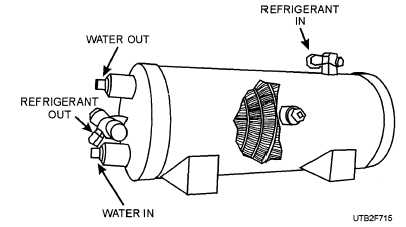WATER - COOLED CONDENSERS. - Condensing water must be noncorrosive, clean, inexpensive, below a certain maximum temperature, and available in sufficient quantity. The use of corrosive or dirty water results in high maintenance costs for condensers and piping. Dirty water, as from a river, can generally be economically filtered if it is noncorrosive; corrosive water can sometimes be economically treated to neutralize its corrosive properties if it is clean. An inexpensive source of water that must be filtered and chemically treated will probably not be economical to use without some means of conservation, such as an evaporative condenser or a cooling tower.
Water circulated in evaporative condensers and cooling towers must always be treated to reduce the formation of scale, algae, and chalky deposits. Overtreatment of water, however, can waste costly chemicals and result in just as much maintenance as undertreatment.
SHELL-AND-COIL CONDENSERS. - A shell-and-coil water-cooled condenser (fig. 7-15) is simply a continuous copper coil mounted inside a steel shell. Water flows through the coil, and the refrigerant vapor from the compressor is discharged inside the shell to condense on the outside of the cold tubes. In many designs, the shell also serves as a liquid receiver.
The shell-and-coil condenser has a low manufacturing cost, but this advantage is offset by the disadvantage that this type of condenser is difficult to service in the field. If a leak develops in the coil, the head from the shell must be removed and the entire coil pulled from the shell to find and repair the leak. A continuous coil is a nuisance to clean, whereas straight tubes are easy to clean with mechanical tube cleaners. In summary, with some types of cooling water, it may be difficult to maintain a high rate of heat transfer with a shell-and-coil condenser.
SHELL-AND-TUBE CONDENSERS. - The shell-and-tube water-cooled condenser shown in figure 7-16 permits a large amount of condensing surface to be installed in a comparatively small space. The condenser consists of a large number of 3/4- or 5/8-inch tubes installed inside a steel shell. The water flows inside the tubes while the vapor flows outside around the nest of tubes. The vapor condenses on the outside surface of the tubes and drips to the bottom of the condenser, which may be used as a receiver for the storage of liquid refrigerant. Shell-and-tube condensers are used for practically all water-cooled refrigeration systems.
To obtain a high rate of heat transfer through the surface of a condenser, it is necessary for the water to pass through the tubes at a fairly high velocity. For this reason, the tubes in shell-and-tube condensers are separated into several groups with the same water traveling in series through each of these various groups. A condenser having four groups of tubes is known as a four-pass condenser because the water flows back and forth along its length four times. Four-pass condensers are common although any reasonable number of passes may be used. The fewer the number of water passes in a condenser, the greater the number of tubes in each pass.
The friction of water flowing through a condenser with a few passes is lower than in one having a large number of passes. This means a lower power cost in pumping the water through a condenser with a smaller number of passes.
TUBE-WITHIN-A-TUBE CONDENSERS. - The use of tube-within-a-tube for condensing purposes is popular because it is easy to make. Water passing

Figure 7-15. - A typical shell-and-coil water-cooled condenser.
Continue Reading